A new generation of lidar systems based on diode-pumped alexandrite lasers is advancing atmospheric science by providing wind and temperature data on a 24/7 basis for altitudes reaching up to 100 km.
ANDREAS THOSS, CONTRIBUTING EDITOR
As anyone who has ever worked with an alexandrite laser can attest, its lasing medium demands respect. “It has about every problem a laser
engineer can imagine,” said Josef
Höffner, a scientist at the Leibniz Institute of Atmospheric Physics (IAP) in Kühlungsborn, a small town on the shores of the Baltic Sea in northern Germany.
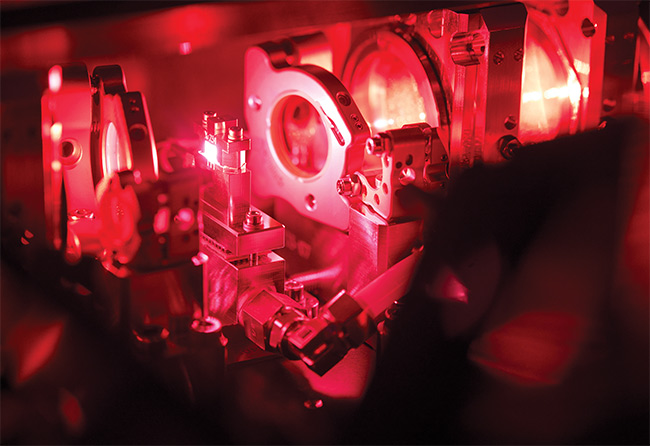
Although the use of alexandrite as a laser crystal has inherent challenges, alexandrite lasers are a promising tool for the lidar systems used in breakthrough
atmospheric research.
Alexandrite offers a broad emission
band in the red and near-infrared regions
and long storage times leading to high pulse energies, which, despite the
medium’s inherent challenges, make
alexandrite the preferred laser source for addressing metal atoms, such as potassium, in the upper atmosphere. These qualities also help to explain why Höffner has used alexandrite lasers for atmospheric science for more than 30 years.
In the 1990s, he built his first flashlamp-pumped alexandrite system for atmospheric lidar measurements. Using some sophisticated tricks, such as the
so-called ramp-and-fire method, he pushed it to deliver narrow bandwidths and a reasonably high pulse power. As the only transportable system of its kind, Höffner’s early alexandrite laser system traveled the world from the North to the South Pole.
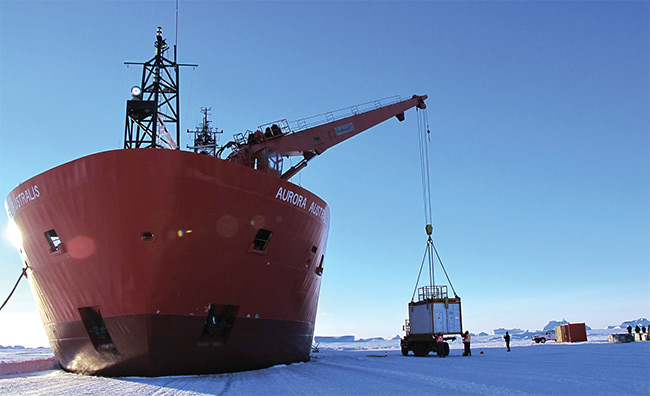
Leibniz IAP’s early alexandrite-based lidar system (photographed at The Davis Station in Antarctica) traveled the world as the first movable lidar system capable of capturing atmospheric measurements at altitudes up to about 100 km. ‘Movable’ in this case means that it filled a standardized shipping container and took 30 kW of power to operate. Courtesy of Josef Höffner/Leibniz IAP.
The laser resonator, with all electronics and the telescope, barely fit into a standard shipping container and had a total weight of 10 tons. The system required 30 kW of power to operate, and it needed a very well-trained operator to get it to lase.
“That was a great system, but its operation was not sustainable,” Höffner said. So, in the early 2000s he looked for partners to help him update the laser technology to consume less power, to enable a more compact and transportable atmospheric lidar system that could deliver reliable 24/7 operation in rugged environments. He found his collaborators in Aachen, Germany, at the Fraunhofer Institute for Laser Technology (ILT).
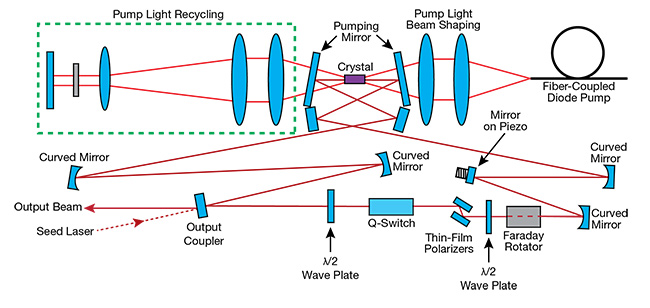
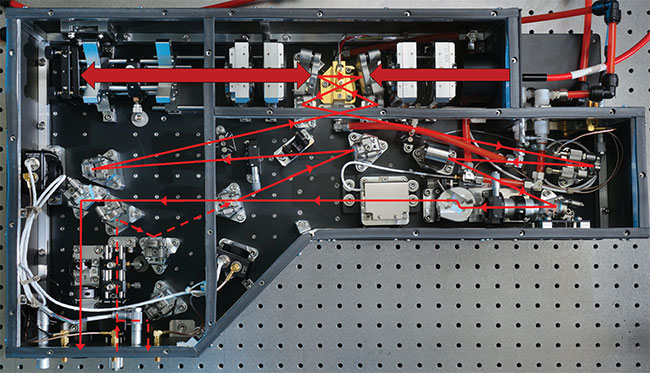
The complete resonator for the alexandritebased lidar system has a length of 2 m (top). Thanks to extensive folding of the beam path, the system fits on a small breadboard (bottom). Courtesy of Fraunhofer ILT.
It took another 10 years of collaborative research to develop the technology to a point where it fulfilled all requirements
to allow the teams from Leibniz IAP
and Fraunhofer ILT to further probe the atmosphere for scientific insights. Now four units are working well, and the
collaborators are making plans for the future.
Probing the heights
The parameters of an atmospheric lidar system are defined by the atmospheric physics the system is supposed to analyze. First, there is wind, which lidar measures via the Doppler shift apparent in changes in backscattered light caused by moving atmospheric particles. Next, lidar measures temperature via Doppler broadening.
Both measurements rely on optical scattering effects, such as the Rayleigh scattering of light caused by air molecules, which is the effect that makes the sky appear blue. Measurement via Rayleigh scattering works well for altitudes up to about 60 km. Measurement via Mie scattering, which is caused by aerosols such as dust or volcanic ash in the atmosphere, works well for altitudes up to about 30 km.
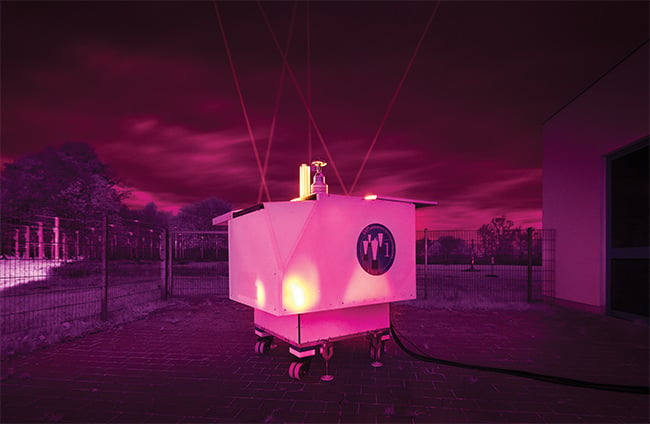
The lidar system based on a diode-pumped alexandrite laser. The system sends out one vertical and four tilted beams to capture horizontal and vertical components of wind at heights reaching 100 km and beyond. Courtesy of Fraunhofer ILT/Ralf Baumgarten.
For altitudes above 60 km, measurement via resonance scattering is the way to go. Atmospheric lidar measurements based on this effect rely on the scattering of metal atoms left over from meteorites or space trash that burned to dust when entering the atmosphere. It is in this region where the space shuttle’s nose starts to glow upon reentry (at about 120 km) and where meteorites become visible (at about 80 to 100 km).
But because very few metal atoms from debris are dispersed at such altitudes, a ground-based lidar system must have the power and sensitivity to measure one atom per cubic centimeter at these heights. Although the concentration of
metal atoms is low, the scattering cross section for resonance scattering is several orders larger than that for the other scattering effects. Therefore, lidar experts love using this star dust to capture measurements. Notably, the guide stars on which modern astronomers rely are typically single metal (sodium) atoms 90 km above Earth’s surface.
Laser pulses offer an effective way to probe these atmospheric particles so
that the returning scattered light can be collected by a telescope on Earth. Of course, a bigger telescope can collect more photons and thus enable a lidar system to probe higher altitudes. Single-photon counting, however, becomes the name of the game for signal detection in such applications. The traveling time of the lidar signal is directly proportional to the height of the scattering particle, and the signal strength of a scattering effect can be used to calculate the concentration of a scattering medium.
The scattering effects targeted put different constraints on the laser. For resonance scattering, the laser wavelength has to match precisely with the resonance of the selected metal atom species. Lasers targeting the potassium D1 spectral emission line, for example, must emit at 770 nm. For probing iron particles, the requisite laser wavelength is 386 nm.
The linewidth of Rayleigh and resonance scattering is about 1 GHz. Mie
scattering comes from bigger particles; thus, it delivers a much sharper peak below 1 MHz. The laser linewidth must be in the order of a few megahertz to resolve Mie scattering out of Rayleigh scattering. Temperatures in the upper
atmosphere are determined by Rayleigh and resonance scattering. For a temperature measurement with 1 K accuracy, a laser typically must be able to scan a spectrum of 1000 MHz with 1-MHz resolution. Atmospheric lidar experts often work in polar regions or on high mountains. Thus, their laser systems must work reliably day and night under harsh conditions and for weeks at a time.
Laser design for atmospheric lidar
Given the demands of designing a laser for year-long lidar campaigns, Höffner had challenging requirements in mind when he first spoke with the team at Fraunhofer ILT. The team had extensive experience in building rugged lasers for aerospace applications; however, as Fraunhofer ILT project manager Michael Strotkamp said, “Alexandrite is not something you take off the shelf.” Very few people had attempted to build a diode-pumped alexandrite laser, and even fewer had considered the challenging conditions required for atmospheric lidar.
The team at Fraunhofer ILT took on the challenge, starting with the design of a diode-pumping setup for single transversal and longitudinal mode operation. Single transverse mode (or TEM00) lasing pumps only the core of the laser crystal, which is difficult to achieve using lateral (i.e., flashlamp) pumping configurations. So, the team focused the diode lasers into a double cone with an 0.8-mm focus diameter.
Alexandrite has an absorption band centered at about 600 nm. To minimize the heat generation caused by quantum defects, the team chose a pump wavelength at the upper end of this absorption band, at 638 nm.
This wasn’t a standard diode wavelength in 2014, when the laser was in development. But the team could begin experimenting with a pump laser delivering 80 W of peak power. The laser’s repetition rate was limited by the requirement that all pulses should be processed in real time. A pulse needs 0.3 ms to travel 90 km, so the next pulse should start about 1 ms later. Within this time window, the laser is tuned.
The first alexandrite laser produced by Fraunhofer ILT that fulfilled all spectral requirements delivered 0.15 W at 770 nm. Improved pump beam shaping (polarization coupled and symmetrized) enabled output power of 0.8 W. After a few iterations, a fiber-coupled pump source with 400 W peak power achieved a system with outputs as high as 2.3 W, or 4.6 mJ, at 500-Hz repetition rates. At 750 Hz, the laser even managed an output of 2.7 W,
or 3.6 mJ.
Ramp and fire
Getting the alexandrite laser to exhibit narrow-bandwidth operation took further refinements. Its ring laser is injection-seeded by a continuous-wave (CW) laser. The injection seeding technique in this case involves a ramp-and-fire procedure in which a CW laser with a narrow bandwidth is fed into a Q-switched resonator at the beginning of the pump pulse.
The injection is triggered by a moving
mirror. To understand how this works, one could see the whole resonator as an etalon, or a Fabry-Pérot interferometer (FPI). The mirror moves (signaling the “ramp” step), and when the etalon’s optical length is an exact multiple of half of the seed wavelength, the system lets the seed laser beam into the resonator. The resonator is Q-switched at exactly this moment (signaling the “fire” step) and the pulse builds up at the designated wavelength.
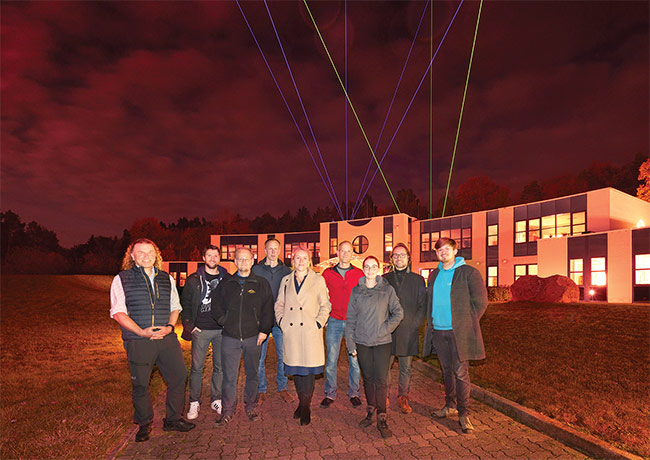
Teams from Leibniz IAP and Fraunhofer ILT met in November 2022 to install the next generation of alexandrite lasers in one of the VAHCOLI project’s four lidar systems. Courtesy of Fraunhofer ILT/Ralf Baumgarten.
The seed laser in the team’s design is a tunable single-mode DL pro 100 diode laser from TOPTICA Photonics. The wavelengths from the seed and the main lasers are constantly monitored and compared to the signal from a thumb-size gas cell, in which potassium atoms are measured with Doppler-free spectroscopy to provide an absolute reference for the system. All other lasing or spectroscopic measurements can be performed and calibrated relative to this signal. This allows, for example, the seed laser and subsequently the alexandrite laser to scan a typical spectrum of ±1000 MHz with step sizes of 1 MHz around a given center wavelength. The team achieved a linewidth of the pulsed laser of 3 MHz. The spectroscopic measurements and the control of the lasers are performed in real time in between adjacent lidar pulses.
The control unit for the lasers is only one part of the measurement architecture
of the team’s lidar device. The most
salient part of the system is the large
telescope in the center of the lidar instrument. The laser is aligned with microradian precision to parallel the telescope axis.
The system aims a beam directly upward, which could limit its measurements to the vertical column of air above it. Therefore, the lidar engineers added four slightly smaller telescopes to the system, each tilted by 30°. The laser is switched to progressively probe all five directions. The telescopes collect returning photons and send them through several tunable etalons to collect atmospheric data. The team recently published details of its alexandrite laser, lidar system, and
spectroscopy setup in Atmospheric
Measurement Techniques1.
It should be noted that this system is designed for single-atom spectroscopy, a technique similar to those applied in cold atom-based quantum computers and optical clocks. In the 1990s, Höffner’s navigation of the challenges inherent to single-atom spectroscopy helped push forward the development of the ultralow-drift single-mode seed lasers that have since become available as off-the-shelf sources for current quantum experiments.
What to do with such a system
In 1996, the alexandrite-based flashlamp-pumped lidar systems from Leibniz IAP enabled groundbreaking research. They were the first to measure temperatures in the atmosphere’s mesopause region over the Antarctic, 80 to 105 km above sea level.
Within the last 15 years, the weight of these lidar systems has dropped from 10,000 kg to 1500 kg, and to 500 kg in the most recent 500-W version.
The newly developed diode-pumped system was first used in January 2020 in a six-week campaign under field conditions, during which the system reliably worked 24/7 without additional alignment. The spectroscopic system is capable of daylight operation, which is particularly important for summer campaigns in polar regions.
The developments underlying Leibniz IAP’s lidar system were funded through several initiatives, including the network of global lidar systems planned under the Vertical and Horizontal Coverage by
Lidars (VAHCOLI) project. The system introduces the capability to measure vertical currents in the atmosphere. This capability is enabled by the four tilted telescopes. Thus, the technology is set to characterize the three-dimensional and time-dependent morphology of Earth’s atmospheric flow. Specifically, it will help disentangle the temporal from spatial variability of the atmosphere’s main flow from its fluxes. The knowledge derived will be beneficial for future climate modeling.
Further developments of the system could take several different directions. The current lidar system has been transferred into a network of local enterprises for serial production. Ten partners are involved to make the technology avail-
able to a wider range of governmental
and commercial users. Climate modeling and weather reporting are its most obvious applications. The system could also be used to provide real-time wind data from altitudes up to 100 km, which
might be of interest to rocket launch facilities.
The team at Fraunhofer ILT is also
further developing an amplifier stage for the system. Next on the agenda is a system designed to probe UV wavelengths, which could target iron atoms in the atmospheric layers beyond 80 km. These plans include development of intracavity second-harmonic generation for the laser, to provide higher efficiency and better long-term stability.
The base technology will also raise
actual atmospheric research to a new level. Two new UV lidar systems based on current designs will travel around Europe for atmospheric measurement campaigns. Together, they will cover an area of some 10,000 sq km and altitudes from 5 to about 100 km. The plan is to feed their data into European databases in real time.
And the growing teams from Fraunhofer ILT and Leibniz IAP will continue their partnership. In the future, their systems will deliver a substantial input for climate models. For the first time, humans will be able to measure climate data over large areas in the sky for extended periods.
Acknowledgments
The author would like to thank Michael
Strotkamp of Fraunhofer ILT and Josef Höffner of Leibniz IAP and their teams for extensive briefings.
Reference
1. F.-J. Lübken and J. Höffner (2021).
VAHCOLI, a new concept for lidars: technical setup, science applications, and first measurements. Atmos Meas Tech, Vol. 14, pp. 3815-3836, www.doi.org/10.5194/amt-14-3815-2021.